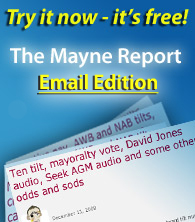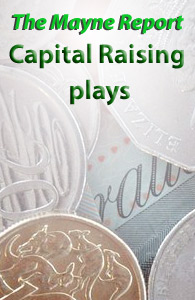Zinifex outrages, super governance, Rich List and much more
February 2, 2010
Dear Mayne Reporters,
in tonight's edition we're up in arms about Oxiana CEO Owen Hegarty copping a $10.7 million payout, $9 million in cash, as part of the $9 billion merger with Zinifex. And didn't they spin it to a gullible media well, whilst delaying the disclosure until after Zinifex shareholders voted on the merger.
In other stories tonight, there is the share dealing which opens the possibility of fronting a Babcock class action, 26 new Rich Listers, audio of Gold Walkley winner Hedley Thomas talking about the size of his Queensland Gas pay packet, our five most popular AGM audios, plus an extract from a recent trade magazine on what appears to be poor disclosure and governance at Australian super funds.
Click through to enjoy the full edition and keep doing ya best, Stephen Mayne
* The Mayne Report is a multi-media governance website published by Stephen Mayne with occasional email editions. To unsubscribe from the emails click here.
in tonight's edition we're up in arms about Oxiana CEO Owen Hegarty copping a $10.7 million payout, $9 million in cash, as part of the $9 billion merger with Zinifex. And didn't they spin it to a gullible media well, whilst delaying the disclosure until after Zinifex shareholders voted on the merger.
In other stories tonight, there is the share dealing which opens the possibility of fronting a Babcock class action, 26 new Rich Listers, audio of Gold Walkley winner Hedley Thomas talking about the size of his Queensland Gas pay packet, our five most popular AGM audios, plus an extract from a recent trade magazine on what appears to be poor disclosure and governance at Australian super funds.
Click through to enjoy the full edition and keep doing ya best, Stephen Mayne
* The Mayne Report is a multi-media governance website published by Stephen Mayne with occasional email editions. To unsubscribe from the emails click here.
Why is Owen Hegarty getting $10.7 million?
Owen Hegarty might be a media darling but he's going to suffer a pretty tough month defending this outrageous $10.7 million payout he's getting as part of the Zinifex merger, which has to be approved at the July 18 EGM of the newly created OZ Minerals Ltd.
When specifically asked at this year's Oxiana AGM, chairman Barry Cusack declined to disclose Hegarty's payout and the cynicism of not publicly revealing it until the day after Zinifex shareholders voted on Monday was just breath-taking.
Even more amazing was the gullible media and spin on show. The AFR and The Age both covered Monday's Zinifex EGM where the dynamic duo of Hegarty and his successor Andrew Michelmore held a press conference to talk up acquisition opportunities. Both papers then fell for a sucker follow-up briefing on Tuesday, according to Barry Fitzgerald's account in The Age today, which included the following:
Joining Mr Michelmore in his Freshwater Place office, Mr Hegarty said that while the friendly nature of the merger had minimised the threat of an interloper, there was no doubt "plenty of people are looking" and would continue to do so.
"No worries about that," Mr Hegarty said. "They'd be looking at all the different options — buying Zinifex, buying Oxiana, buying the merged entity."
So the CEO getting a $10.7 million payout and the bloke who shouldn't be the OZ Minerals CEO get together and make some vague comments about takeovers and this is bigger news than one of the biggest termination deals we've ever seen in the Australian market. The AFR and The Age are yet to even report it, let alone rail against an obvious scandal.
Even The Australian under-cooked the yarn by burying it in Rebecca Urban's gossip column, but at least the Herald Sun ran it as a stand alone story in their business pages today.
Have a look at page four of the Oxiana notice of meeting to see Owen's payout in its full glory. It stacks up as follows:
* $2.29 million in base salary up until the end of 2009, a whopping 18 months
* retention payments of $160,000 in cash and 500,000 shares valued at $1.56 million
* $5.4 million in cash for the cancellation of 6 million options that were due to vest in 2009, 2010 and 2011.
In addition, Hegarty was one of those blokes who rarely took holidays so there is $950,000 in annual and long service leave which doesn't need shareholder approval.
There really are serious problems with Australia's takeover laws because retiring CEOs continually negotiate themselves huge farewell packages in order to give it their blessing. Regular shareholder get one price and retiring CEOs negotiate their own special premium.
If Hegarty thinks this merger is so good, why on earth couldn't he keep those 6 million options and ride with the market, rather than getting $5.4 million in cash which looks massively overdone when you consider that Oxiana shares have tumbled 30% since the deal was announced.
No wonder the smiling Hegarty is going around saying "keep your eye on the prize", and making cheerful joint appearances with Michelmore on Lateline Business.
Of course Owen's talking up the merger and happily going non-executive whilst being paid $9 million in cash upfront as if he'd achieved his performance hurdles as a CEO over the next three years.
The proxy advisers will no doubt have a close look at this and both sets of shareholders will have a chance to protest against the Zinifex directors joining the board, Michelmore's appointment to the board, Owen's payout and the proposed increase in maximum board fees from $1.5 million to $2.7 million.
I'll also be pushing for a protest vote against Zinifex chairman Peter Mansell who is the busiest man in Australia and hasn't covered himself in glory as the chairman of WA News.
When specifically asked at this year's Oxiana AGM, chairman Barry Cusack declined to disclose Hegarty's payout and the cynicism of not publicly revealing it until the day after Zinifex shareholders voted on Monday was just breath-taking.
Even more amazing was the gullible media and spin on show. The AFR and The Age both covered Monday's Zinifex EGM where the dynamic duo of Hegarty and his successor Andrew Michelmore held a press conference to talk up acquisition opportunities. Both papers then fell for a sucker follow-up briefing on Tuesday, according to Barry Fitzgerald's account in The Age today, which included the following:
Joining Mr Michelmore in his Freshwater Place office, Mr Hegarty said that while the friendly nature of the merger had minimised the threat of an interloper, there was no doubt "plenty of people are looking" and would continue to do so.
"No worries about that," Mr Hegarty said. "They'd be looking at all the different options — buying Zinifex, buying Oxiana, buying the merged entity."
So the CEO getting a $10.7 million payout and the bloke who shouldn't be the OZ Minerals CEO get together and make some vague comments about takeovers and this is bigger news than one of the biggest termination deals we've ever seen in the Australian market. The AFR and The Age are yet to even report it, let alone rail against an obvious scandal.
Even The Australian under-cooked the yarn by burying it in Rebecca Urban's gossip column, but at least the Herald Sun ran it as a stand alone story in their business pages today.
Have a look at page four of the Oxiana notice of meeting to see Owen's payout in its full glory. It stacks up as follows:
* $2.29 million in base salary up until the end of 2009, a whopping 18 months
* retention payments of $160,000 in cash and 500,000 shares valued at $1.56 million
* $5.4 million in cash for the cancellation of 6 million options that were due to vest in 2009, 2010 and 2011.
In addition, Hegarty was one of those blokes who rarely took holidays so there is $950,000 in annual and long service leave which doesn't need shareholder approval.
There really are serious problems with Australia's takeover laws because retiring CEOs continually negotiate themselves huge farewell packages in order to give it their blessing. Regular shareholder get one price and retiring CEOs negotiate their own special premium.
If Hegarty thinks this merger is so good, why on earth couldn't he keep those 6 million options and ride with the market, rather than getting $5.4 million in cash which looks massively overdone when you consider that Oxiana shares have tumbled 30% since the deal was announced.
No wonder the smiling Hegarty is going around saying "keep your eye on the prize", and making cheerful joint appearances with Michelmore on Lateline Business.
Of course Owen's talking up the merger and happily going non-executive whilst being paid $9 million in cash upfront as if he'd achieved his performance hurdles as a CEO over the next three years.
The proxy advisers will no doubt have a close look at this and both sets of shareholders will have a chance to protest against the Zinifex directors joining the board, Michelmore's appointment to the board, Owen's payout and the proposed increase in maximum board fees from $1.5 million to $2.7 million.
I'll also be pushing for a protest vote against Zinifex chairman Peter Mansell who is the busiest man in Australia and hasn't covered himself in glory as the chairman of WA News.
Corporate governance at super funds
Investment & Technology Magazine reporter Catherine James produced an excellent cover story on super fund governance this month which perhaps signals a new frontier for the debate - who's watching the investors? These are the quotes where we dipped our oar in:
Shareholder activist Stephen Mayne suggests that more frequent disclosure may actually lead to more member engagement anyway, removing the 'members-aren't-interested-so-why-disclose?' argument.
"I get the sense that the level of engagement with fund members is pretty poor. And they're a thoroughly disengaged group of constituents - they don't understand, they're not interested, they're not being engaged, and everyone seems to be doing the bare minimum.
That whole culture doesn't actually promote good governance - supported by accountability, transparency and disclosure," Mayne says.
Nor does Mayne think more frequent disclosure of financial positions would promote short-termism in members, just as company disclosure does not prevent people investing for the long term.
"It's not that much different from the daily publication of a share price, is it? I mean, they would have a regular assessment of the value of the portfolio - it's worked out by management and presented to the board. They're always getting updates. I can't see why more of that information can't be released on the website of the super fund so that members who are interested can access it," he says.
"I think people are mature enough to say we are investing for the long term and this is the snap shot of where we're currently at."
Mayne is scathing of the inaccessibility of financial reports, but he's more critical of the non-disclosure of executive pay in audited reports. The matter of disclosing pay is a small but stark difference between what super funds and listed companies are required to include on their audited reports.
"It's good practice - we can see if people are getting ripped off. I mean why should a super fund be able to secretly give $5 million bucks to the chief executive and not disclose it? Politicians pay is disclosed, directors fees are disclosed: it's ridiculous in this era of remuneration disclosure that we've got a trillion dollars of super fund money out there being managed by people on secret salaries."
Mayne suggests that super funds managing above a determined amount should have to disclose executive and director pay as good disclosure practice.
"I get the sense that the level of engagement with fund members is pretty poor. And they're a thoroughly disengaged group of constituents - they don't understand, they're not interested, they're not being engaged, and everyone seems to be doing the bare minimum.
That whole culture doesn't actually promote good governance - supported by accountability, transparency and disclosure," Mayne says.
Nor does Mayne think more frequent disclosure of financial positions would promote short-termism in members, just as company disclosure does not prevent people investing for the long term.
"It's not that much different from the daily publication of a share price, is it? I mean, they would have a regular assessment of the value of the portfolio - it's worked out by management and presented to the board. They're always getting updates. I can't see why more of that information can't be released on the website of the super fund so that members who are interested can access it," he says.
"I think people are mature enough to say we are investing for the long term and this is the snap shot of where we're currently at."
Mayne is scathing of the inaccessibility of financial reports, but he's more critical of the non-disclosure of executive pay in audited reports. The matter of disclosing pay is a small but stark difference between what super funds and listed companies are required to include on their audited reports.
"It's good practice - we can see if people are getting ripped off. I mean why should a super fund be able to secretly give $5 million bucks to the chief executive and not disclose it? Politicians pay is disclosed, directors fees are disclosed: it's ridiculous in this era of remuneration disclosure that we've got a trillion dollars of super fund money out there being managed by people on secret salaries."
Mayne suggests that super funds managing above a determined amount should have to disclose executive and director pay as good disclosure practice.
Buying on the dips and crystallising a Babcock loss
I've crystallised the loss on five of my six Babcock & Brown unsecured notes so as to potentially qualify as the named plaintiff in a class action if the banks do indeed stop the interest payments as we've now belatedly discovered they have the power to do. However, the notes have rocketed back to $60, suggesting the solvency fear was overblown, so my $36 sale price is looking pretty woeful
Apart from that it has been all buying over the past week, including two listed Babcock vehicles that had been accidentally overlooked. The timing was good as the paper profit on that $1000 Babcock splash has already more than covered the brokerage. Herewith is the recent trading on the portfolio which now numbers more than 700 stocks worth 176,411 with a margin loan of $34,146:
June 18
Aberdeen Leaders: bought 295 at $1.70
June 17
Strike Resources: bought 2,000 at 25c
SDI Ltd: bought 264 at $1.90
June 16
Destra Corp: bought 9,091 at 5.5c
Babcock & Brown convertible notes: sold 5 at $36
June 13
Clinuvel Pharmaceuticals: bought 1516 at 33c
Babcock & Brown Japan Property Trust: bought 600 at 84.5c
Hill End Gold: bought 2000 at 25c
Babcock & Brown Capital: bought 170 at $3.01
Apart from that it has been all buying over the past week, including two listed Babcock vehicles that had been accidentally overlooked. The timing was good as the paper profit on that $1000 Babcock splash has already more than covered the brokerage. Herewith is the recent trading on the portfolio which now numbers more than 700 stocks worth 176,411 with a margin loan of $34,146:
June 18
Aberdeen Leaders: bought 295 at $1.70
June 17
Strike Resources: bought 2,000 at 25c
SDI Ltd: bought 264 at $1.90
June 16
Destra Corp: bought 9,091 at 5.5c
Babcock & Brown convertible notes: sold 5 at $36
June 13
Clinuvel Pharmaceuticals: bought 1516 at 33c
Babcock & Brown Japan Property Trust: bought 600 at 84.5c
Hill End Gold: bought 2000 at 25c
Babcock & Brown Capital: bought 170 at $3.01
The burgling of Hedley Thomas by Queensland Gas
I gave a speech to about 60 spindoctors in Melbourne last night and sitting around having a few wines afterwards, we got onto the topic of journalistic and PR wages.
It is true that journo pay is under pressure due to structural challenges for the industry but many are cashing in by selling out to public companies. Witness the way The AFR's former investment editor John Hurst accepted more than $300,000 a year to spruik for that house of cards known as MFS.
The incumbent Gold Walkley winner Hedley Thomas shocked many people late last year when he quit The Australian to become the spindoctor for that emerging giant Queensland Gas.
It was covered at the time in Crikey, but we've now got hold of the audio from the recent PR conference where Hedley was confronted with the question: "How much did Queensland Gas pay to burgle the best investigative journalist in Queensland?" Have a listen.
At 200k, plus an incentive, I reckon Hedley sold himself short because he will be an invaluable resource for this company as it battles regulation, communities and commercial competitors to develop its coal seam methane gas reserves.
Managing regulatory risk, having access to key politicians and generating positive press is a far more important endeavour than many people realise for public companies. Look at the way shares in Macquarie Radio and ABC Learning have plunged since the fall of John Howard.
When it comes to regulatory risk, the biggest sell in this market is banks. Labor is watching the big consumer court cases in Britain over bank fees and if the same thing happened here, banks would find fee revenue falling by billions.
It is true that journo pay is under pressure due to structural challenges for the industry but many are cashing in by selling out to public companies. Witness the way The AFR's former investment editor John Hurst accepted more than $300,000 a year to spruik for that house of cards known as MFS.
The incumbent Gold Walkley winner Hedley Thomas shocked many people late last year when he quit The Australian to become the spindoctor for that emerging giant Queensland Gas.
It was covered at the time in Crikey, but we've now got hold of the audio from the recent PR conference where Hedley was confronted with the question: "How much did Queensland Gas pay to burgle the best investigative journalist in Queensland?" Have a listen.
At 200k, plus an incentive, I reckon Hedley sold himself short because he will be an invaluable resource for this company as it battles regulation, communities and commercial competitors to develop its coal seam methane gas reserves.
Managing regulatory risk, having access to key politicians and generating positive press is a far more important endeavour than many people realise for public companies. Look at the way shares in Macquarie Radio and ABC Learning have plunged since the fall of John Howard.
When it comes to regulatory risk, the biggest sell in this market is banks. Labor is watching the big consumer court cases in Britain over bank fees and if the same thing happened here, banks would find fee revenue falling by billions.
Top 5 AGM audios of all time
The following are our most popular AGM audio exchanges so far and it is good to see we're now getting up into the hundreds. My personal favourite is the MFS blast:
Attempt to nail Babcock director Joe Raby with resurrection of Alan Bond - slapped down by Nosworthy - available since May 31
- 837 visits
Addressing B&B chairman about the fundamental problems with the current Babcock model - available since May 31
- 581 visits
Blasting MFS for blaming everyone but themselves - since March 28
- 351 visits
Speaking against the re-election of John McFarlane to the Westfield board - available since May 23
- 332 visits
Campaign speech for a board position on WA News - available since April 23
- 285 visits
- 837 visits
Addressing B&B chairman about the fundamental problems with the current Babcock model - available since May 31
- 581 visits
Blasting MFS for blaming everyone but themselves - since March 28
- 351 visits
Speaking against the re-election of John McFarlane to the Westfield board - available since May 23
- 332 visits
Campaign speech for a board position on WA News - available since April 23
- 285 visits
Another 26 new Rich Listers
The Mayne Report Rich List continues to grow in size and popularity with almost 13,000 page views so far and another 26 names in tonight's edition as crash 1100 and continue the chase to the eventual 2000 or so that we expect will quality against our $10 million threshhold. My favourite new entry is this cashed up Queensland fruit grower:
John Savio: the Stanthorpe-based apple grower is cashed up and flying if you can believe a report in The AFR on Tuesday which revealed he is set to purchase a Brisbane office block from GE Real Estate for a lazy $88 million.
Most of these following names have been sourced from WA Business News which has done a great job tracking the new resources driven wealth in Perth:
Anthony Bohnenn: chairman of Perth-based Grange Resources, his share wealth is north of $20 million.
Tony Brady: founder of the Brady Group, a Melbourne-based high-rise property developer, who is planning two 30-level towers for Little Lonsdale St which would add to the other two properties he's got on the same street.
Alan Brierty: managing director of WA-based Brierty, his share wealth is north of $20 million.
Robert Brown: deputy-chairman of Perth-based Cedar Woods Property, his share wealth is north of $30 million.
Stanley Brown: of Perth-based Cedar Woods Property, his share wealth is north of $15 million.
Alexander Burns: non-executive chairman of Perth-based Shield Mining, his share wealth is north of $15 million.
Terence Byrt: non-executive chairman of Perth-based East Energy Resources, his share wealth is north of $30 million.
Peter Diamond: executive chairman of WA-based Euroz, his share wealth is north of $15 million.
Robert Disbrow: of Perth-based Albidon, his share wealth is around $20 million.
Deryck Graham: non-executive director of WA-based Quickstep Holdings, his share wealth is just below $20 million.
Mervyn Greene: chairman of WA-based Deep Yellow uranium mining, his share wealth is upward of $20 million.
William Hames: chairman of Perth-based Cedar Woods Property, his share wealth is north of $25 million.
Peter Harold: of Perth-based Sally Malay Mining, his share wealth is around of $25 million.
Gavin Hawkins: executive director of Perth-basedd Aspen Group, his share wealth is north of $20 million.
Jay Hughes: executive director of WA-based Euroz, his share wealth is north of $15 million.
George Jones: chairman of Perth-based Gindalbie Metals, his share wealth is around $15 million.
Peter Joseph: chairman of Perth-based Dominion Mining, his share wealth is upward of $40 million.
Andrew Kent: chairman of Perth-based Aspermont, his share wealth is upward of $40 million.
Donna Loxton: of Perth-based Sundance Resources, her share wealth is upward of $15 million.
Nathan Mahalingam: managing director of Perth-based Mission Biofuels, his share wealth is north of $15 million.
Andrew Mckenzie: managing director of WA-based Euroz, his share wealth is north of $15 million.
Ian Middlemas: director of several energy and resources companies, his combined share wealth is upward of $25 million.
David Moore: managing director of Perth-based Mincor Resources, his share wealth is north of $15 million.
David Reed: executive chairman of Perth-based Reed Resources, his share wealth is north of $15 million.
David Rodwell: a South African buisnessman living in Perth. He has extensive retail investments and founded Shoe City which now has dozens of branches across Australia. A previous owner of the Perth Glory, his wealth is estimated at over $200 million.
Rod Smith: of Perth-based Sundance Resources, his share wealth is upward of $15 million.
Rosanne Swick: of Perth-based Swick Mining, her share wealth is upward of $40 million.
Joseph Treasy: executive director of Perth-based Kagara Zinc, his share wealth is around $20 million.
John Savio: the Stanthorpe-based apple grower is cashed up and flying if you can believe a report in The AFR on Tuesday which revealed he is set to purchase a Brisbane office block from GE Real Estate for a lazy $88 million.
Most of these following names have been sourced from WA Business News which has done a great job tracking the new resources driven wealth in Perth:
Anthony Bohnenn: chairman of Perth-based Grange Resources, his share wealth is north of $20 million.
Tony Brady: founder of the Brady Group, a Melbourne-based high-rise property developer, who is planning two 30-level towers for Little Lonsdale St which would add to the other two properties he's got on the same street.
Alan Brierty: managing director of WA-based Brierty, his share wealth is north of $20 million.
Robert Brown: deputy-chairman of Perth-based Cedar Woods Property, his share wealth is north of $30 million.
Stanley Brown: of Perth-based Cedar Woods Property, his share wealth is north of $15 million.
Alexander Burns: non-executive chairman of Perth-based Shield Mining, his share wealth is north of $15 million.
Terence Byrt: non-executive chairman of Perth-based East Energy Resources, his share wealth is north of $30 million.
Peter Diamond: executive chairman of WA-based Euroz, his share wealth is north of $15 million.
Robert Disbrow: of Perth-based Albidon, his share wealth is around $20 million.
Deryck Graham: non-executive director of WA-based Quickstep Holdings, his share wealth is just below $20 million.
Mervyn Greene: chairman of WA-based Deep Yellow uranium mining, his share wealth is upward of $20 million.
William Hames: chairman of Perth-based Cedar Woods Property, his share wealth is north of $25 million.
Peter Harold: of Perth-based Sally Malay Mining, his share wealth is around of $25 million.
Gavin Hawkins: executive director of Perth-basedd Aspen Group, his share wealth is north of $20 million.
Jay Hughes: executive director of WA-based Euroz, his share wealth is north of $15 million.
George Jones: chairman of Perth-based Gindalbie Metals, his share wealth is around $15 million.
Peter Joseph: chairman of Perth-based Dominion Mining, his share wealth is upward of $40 million.
Andrew Kent: chairman of Perth-based Aspermont, his share wealth is upward of $40 million.
Donna Loxton: of Perth-based Sundance Resources, her share wealth is upward of $15 million.
Nathan Mahalingam: managing director of Perth-based Mission Biofuels, his share wealth is north of $15 million.
Andrew Mckenzie: managing director of WA-based Euroz, his share wealth is north of $15 million.
Ian Middlemas: director of several energy and resources companies, his combined share wealth is upward of $25 million.
David Moore: managing director of Perth-based Mincor Resources, his share wealth is north of $15 million.
David Reed: executive chairman of Perth-based Reed Resources, his share wealth is north of $15 million.
David Rodwell: a South African buisnessman living in Perth. He has extensive retail investments and founded Shoe City which now has dozens of branches across Australia. A previous owner of the Perth Glory, his wealth is estimated at over $200 million.
Rod Smith: of Perth-based Sundance Resources, his share wealth is upward of $15 million.
Rosanne Swick: of Perth-based Swick Mining, her share wealth is upward of $40 million.
Joseph Treasy: executive director of Perth-based Kagara Zinc, his share wealth is around $20 million.





















